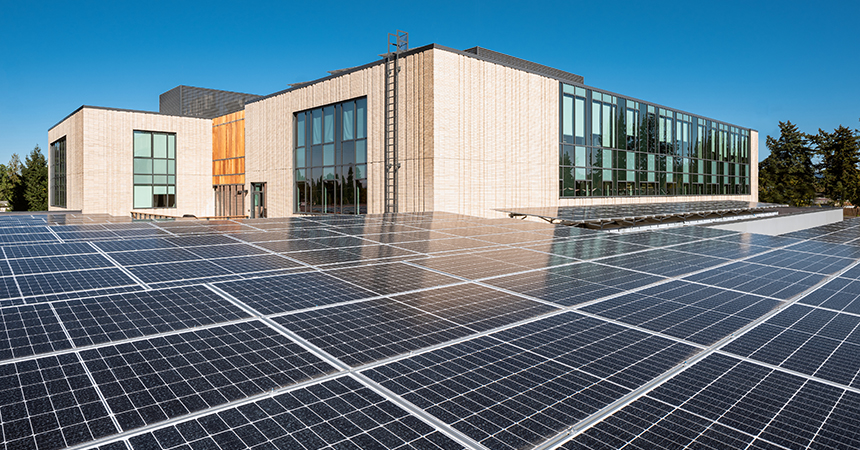
When Beaverton Police needed a larger, more functional home, collaboration with Energy Trust of Oregon and Portland General Electric helped ensure the new building was green and energy resilient. A Path to Net Zero approach and an advanced solar microgrid helped Beaverton create a model that other municipalities can follow.
As a public building, housing both the Police and Emergency Management departments for the City of Beaverton, the facility needed to meet a state mandate for investments in green energy technology and support Beaverton’s climate action plan, which calls for a 100% reduction in community greenhouse gas emissions by 2050. Above all, as the city’s emergency operations center, it needed to be energy resilient and remain operational even during power outages or emergencies such as an earthquake.
The three-story, 72,000-square-foot Beaverton Public Safety Center, which opened in September 2020, hits all those targets thanks to 873 solar panels, battery storage and a highly energy-efficient design that puts the building well on the path to net zero.
A notable feature of this project is that the 331.8-kilowatt solar array—generating enough clean energy to meet 40% of the building’s needs—joins with the battery storage and a diesel standby generator to form a microgrid. This is the first microgrid to serve an emergency operations center in Oregon.
The microgrid benefits the community by providing both critical resiliency for the safety center as well as interactive services for the larger electrical grid. Day in and day out, PGE can draw on solar energy stored in the battery to supply clean energy to the grid during peak periods. But if there’s an outage, earthquake or other disruption, the building is automatically served by the stored solar power.
“We decided if we could make it more of a green building and create our own solar power rather than burning more fossil fuels—and provide extra energy back to the grid that PGE can use when demand is high—it just made sense,” said Eric Oathes, captain, Beaverton Police, who served as project manager for the building’s construction. “As a police facility, we’re operating 24/7, and so we need to make sure we have power all the time. The battery storage gives us a green option as a backup so we’re able to continue providing services to the community if there’s a power outage.”
The battery backup proved its value almost immediately.
“In September 2020, right after we moved in, there was a big thunderstorm that came through. We lost a bunch of power throughout Beaverton, but our emergency backup system kicked right in,” said Oathes.
The microgrid is also working seamlessly to help serve the larger community.
“We have dispatched that battery an average of 10 to 20 times per month as a resource to help keep energy flowing smoothly on the grid. And nobody ever knows the difference. You never see a disturbance. You never see the lights flicker. It just does what it needs to do,” said Darren Murtagh, senior manager, PGE Grid Edge Solutions.
Along with the solar array, the building includes features that make it 70% more energy efficient than the national standard for buildings of this type, which saves money on monthly energy costs and aligns with climate action goals. To achieve that level of energy savings, the City participated in Energy Trust’s Path to Net Zero, which includes incentives and Energy Trust staff involvement from early design through construction. Technical assistance included energy modeling and daylighting studies to identify the best solutions to reach energy-efficiency goals.
A high-efficiency building envelope, advanced HVAC technology, LED lighting and controls, radiant floors and daylighting are some of the features that combine to deliver outstanding energy performance and a comfortable workspace.
Financial help from Energy Trust and PGE helped the project pencil out. Energy Trust incentives totaling $211,000 helped cover part of the costs for the early design studies as well as the solar project. PGE provided about $1.5 million including funding for the battery storage and microgrid controller and a grant from the PGE Renewable Development Fund, which is supported by PGE Green FutureSM renewable energy customers.
“I love the building. It has a nice open feeling compared to our previous building that was small and confined. It’s very bright because of the windows and daylighting,” said Oathes. “And it was designed around the everyday operations of a police officer. About 90% of what they need to do—write reports, evidence processing, custody processing—is right there as they come in the back doors from the secured lot.”
Read the Beaverton Public Safety Center case study for more details.
If you’re planning a new building or major reconstruction in your community, discover how Energy Trust can help you build energy efficiency and solar into your plans.
Photos courtesy of FFA Architecture & Interiors. Photographer- Christian Columbres.
